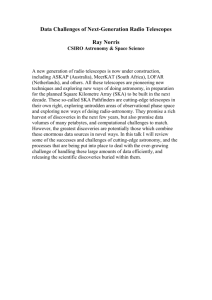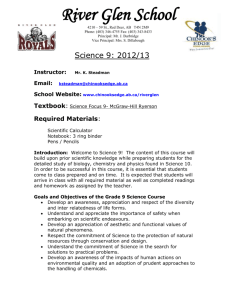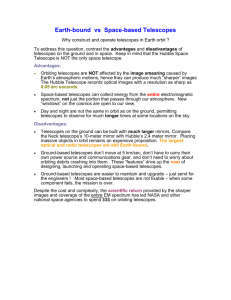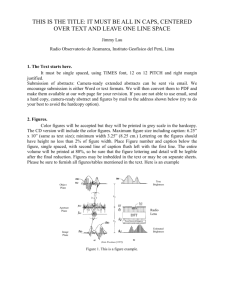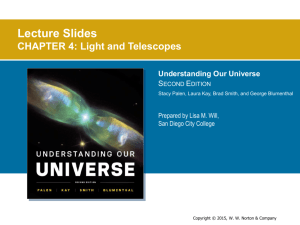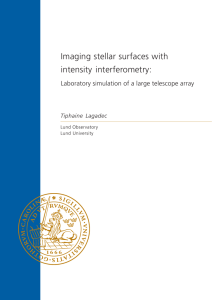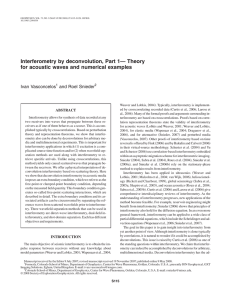Kulkarni-Strategic
advertisement
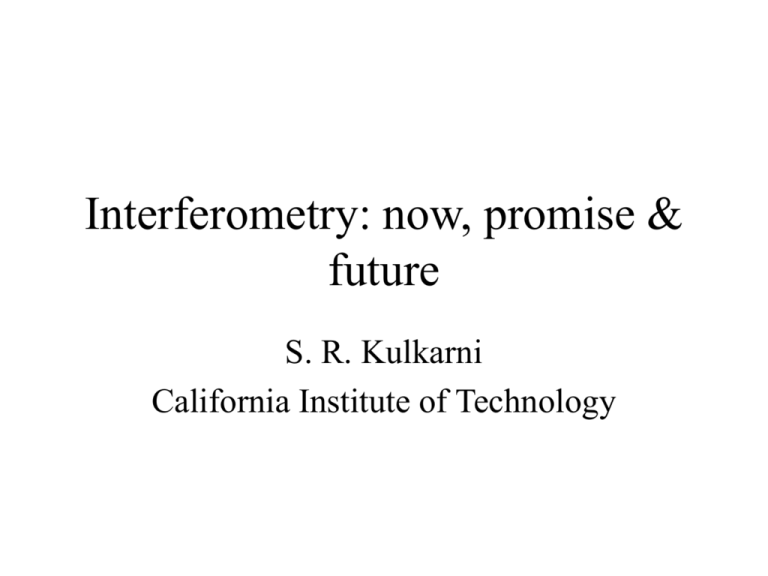
Interferometry: now, promise & future S. R. Kulkarni California Institute of Technology The Really Big Picture • “You do not understand anything unless you can measure it precisely” (Lord Kelvin) • Eventually mature fields demand precise and accurate measurements – eg. CMBR: discovery, wilderness, real understanding – eg. Extra-solar planets: speculation, pulsars timing, precision RV – eg. Nuclear Black holes: Galactic center, OH Megamasers+VLBA The Promise • Stellar Astronomy (all areas) – Birth of stars (e.g. magnetospheric radius) – Physics of stars at the 1% level • This will require improvements across board (opacity, 3-D convection, B fields, rotation) • Black Hole Astrophysics – Nuclear Black holes – Galactic Center • Dynamics – Star clusters – Gloublar clusters – Milky Way Halo Nearby Galaxies as Laboratories The high angular resolution of a sensitive interferometer could potentially make nearby galaxies to be studied in great detail eg. VLA transformed the study of HI from a purely Galactic field to a major area of research Such a step is not only a natural evolutionary step in how our field will progress but is needed for a quantitative understanding of the evolution of the Universe The Scene & the Competition • The two major players by sheer virtue of geometry are – VLTI – Keck Observatory + Mauna Kea telescopes • Subaru, Gemini-N, Gemini-S, HET, SALT, Magellan, GCT, MMT have no future in this area. • LBT has a unique niche and my prediction is that their best science will come out of of their adaptive secondary related science and their interferometry and not the use of LBT as a pair of single telescopes. Keck Interferometry: Based around Key Projects • • • • KI Nulling (exozodi of nearby stars) KI differential phase (hot Jupiters) KIA imaging (broad science, PMS) KOA astrometry (outer planets) ESO VLTI - the competition Four 8-m telescopes (=16-m) Four Auxillary 1.8-m Telescopes 200-m baseline array MIDI (mid-IR beam combiner) AMBER (near IR beam combiner) PRIMA (Phase referencing) GENIE (ESA Nuller) Keck: Possible New Areas of Thrusts • • • • Fizeau imager for outriggers Polarimetric beam combiner (disks) FTS mode High Sensitivity interferometer (AO on outriggers and lasers) • Push to optical wavelengths OHANA -- Truly Unique • Combine major telescopes on Mauna Kea • 800-m baseline • Large collecting area – Analogy: radio astronomers are already on to such an approach (global fringe fitting) Now the ground reality • Interferometry as a subject is lacking a vigorous feeder pipeline – Equivalent to having only 10-m telescopes with no access to smaller telescopes This is a a very serious problem. • Sensitivity has been limited (but dual star mode has overcome this). – Early days of AO An example: PHASES • We have now demonstrated 20 microarcsecond *accuracy* for speckle binaries (Lane & Mutterspaugh, PTI) • We have now embarked on the Phases project at PTI • Do some aspect of SIM science -microarcsecond precision -- within 3 years (by doing Phases at Keck)!! Very Narrow Angle Astrometry Shao & Colavita Scanning the Fringe Lane & Mutterspaugh PHASES Observations Multiple Targets The PHASES Sample What next? • We are on the verge (finally) of great progress in the field. – Need serious thoughts but need visionary thinking • Interferometry is an area where we can excel due to investment and happenstance • Identify whether interferometry has a role in CELT/TMT. • Need a major philosophical rethinking on part of our community
